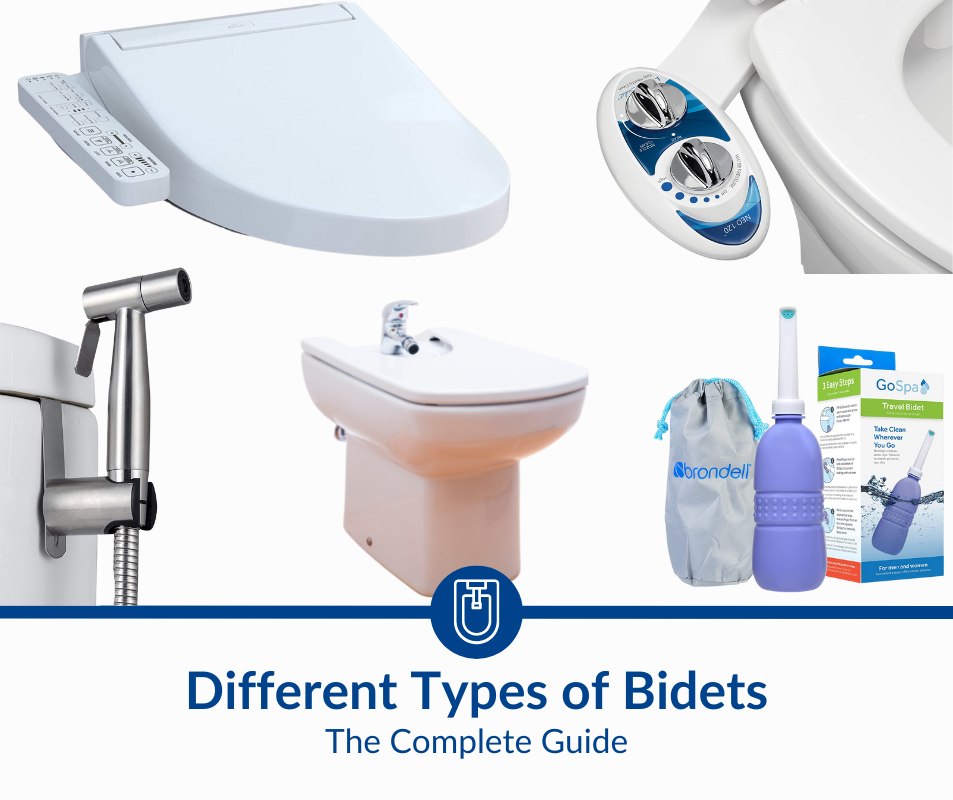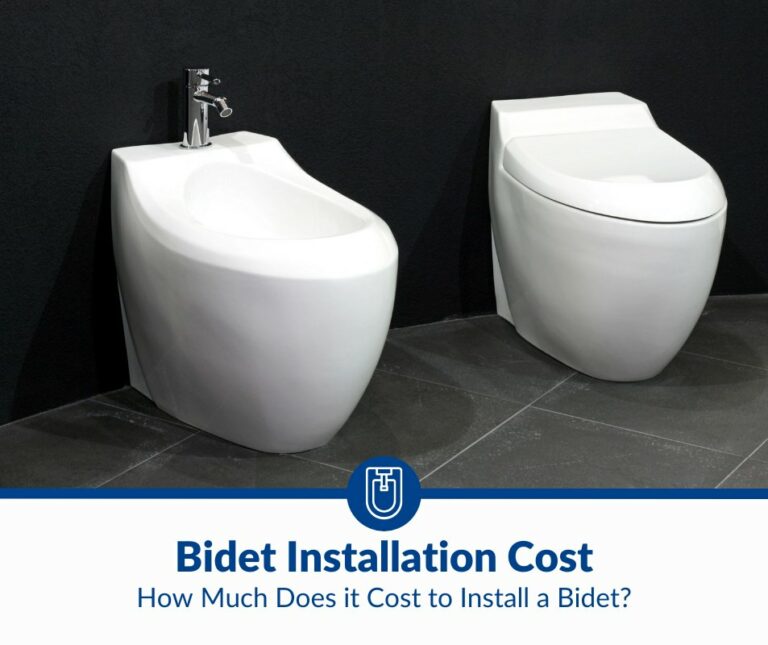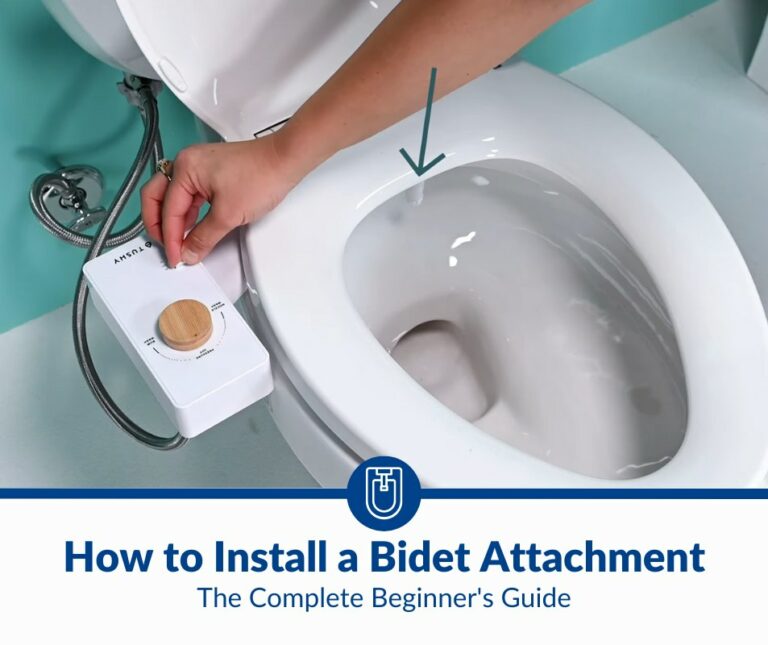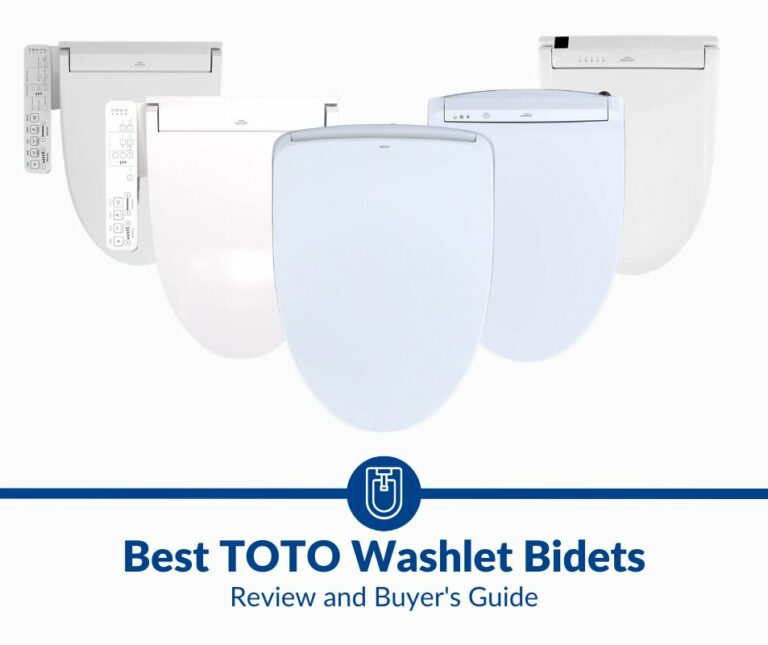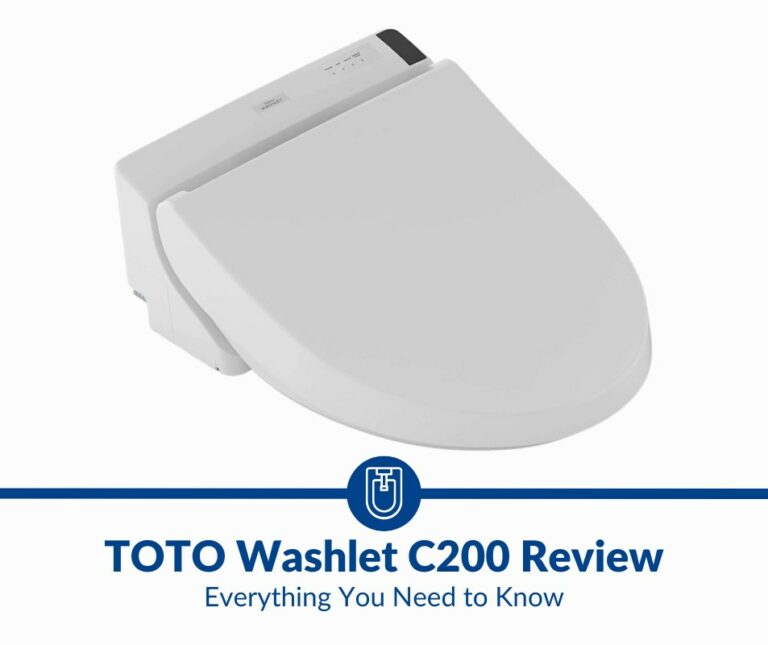Types of Bidets: The Complete Guide
Bidets have become increasingly popular in the United States recently as many people have realized that they offer a more hygienic method of using the bathroom and eliminate the need for toilet paper. If you’re interested in investing in a bidet, what are the types you should consider?
The different types of bidets include standalone, built-in, and handheld models. Other types include attachment, bottle top, and basic bidets. Each bidet type has unique advantages and drawbacks, and your chosen model depends on personal preference.
This article will provide an in-depth overview of the various kinds of bidets you can purchase. Keep reading to learn what you need to know about these cleaning contraptions.
1. Standalone Bidet
A standalone bidet is not attached to your regular toilet in any way. You can choose to have it hanging from the wall or install it directly on the floor. The ability to choose where you want your standalone bidet makes them a flexible option.
However, standalone bidets take up more space, so this may not be the best choice if you have a small bathroom.
Pros
- The price has decreased in recent years. With the advent of more modern and convenient bidet models, there is less demand for standalone bidets. For this reason, their cost has decreased, making them more affordable than ever.
- Some standalone bidets have modern features. It’s relatively easy to upgrade a standalone bidet with temperature and pressure control features.
- Your toilet won’t change at all. Some people don’t like the idea of switching their toilet seat or adding an attachment because they like the way their toilet looks and feels. Installing a standalone bidet doesn’t require changing your current toilet.
Cons
- Standalone bidets can be messy. If you have a standalone bidet, you’ll need to move to the bidet after using the toilet. Presumably, you wouldn’t be cleaning yourself before making this switch because the point of having a bidet is to use it to clean yourself after using the toilet. Therefore, the few seconds it’ll take to get from the toilet to the bidet might make a mess.
- It takes up more space. You’ll need enough space in your bathroom to fit both a toilet and a separate bidet, which isn’t realistic for many people, especially those who live in small homes and apartments.
- The bidet requires separate plumbing. Because the standalone bidet is a separate unit from the toilet, it requires separate plumbing, which is complicated and costly to install.
2. Bidet Toilet Seats
Built-in bidets are incredibly popular because you can install them onto your current toilet. This creates a type of “all-in-one” toilet, saving space and eliminating the mess when moving from a regular toilet to the bidet.
The bidet seat features spray jets inside and underneath the seat that come out when you hit a button to clean yourself.
I recommend the Alpha Bidet Elongated Toilet Seat from Amazon.com because it uses tankless on-demand water heating, so you’ll always have warm water for extra comfort. I also like that it is extremely quiet and discreet, and the self-cleaning features ensure that the seat remains sanitary. Finally, I appreciate the clear and simple remote control, so there’s no learning curve to using this seat.
Pros
- The toilet and the bidet are one appliance. One of the biggest downsides to having a standalone bidet is moving from the toilet to the bidet when you’re ready for cleaning. Luckily, with a built-in bidet, you don’t need to worry about that. The built-in bidet is quicker and more convenient to use than a standalone model.
- Many built-in bidets have multiple features available. Because this type of bidet is so popular, manufacturers continue to improve on their original designs and ideas by adding additional functions, such as warm air dryers, a heated toilet rim, and even the option to add music.
- Most built-in bidet seats have a feminine wash mode. Women, in particular, benefit from owning this type of bidet because of the feminine wash mode many of them have, which ensures that women get thoroughly and hygienically cleaned after urination.
Cons
- Built-in bidets are typically more expensive than other options. If you want the additional features that make owning a bidet so great, you’ll have to pay for them. These costs can add up to an expensive investment.
- The seats aren’t always aesthetically pleasing. If you’re picky about the design scheme in your bathroom, you might not be happy about how the built-in bidet seat looks.
- You’ll need an outlet nearby if you want an electric bidet seat. Electric bidet seats offer fantastic features but require you to have a power outlet in your bathroom. The outlet should also be reasonably close to the bidet.
3. Portable Bidet
The portable or travel bidet might be what you need if you’re always on the go. These bidets look like water bottles, but they have a nozzle on the top you can spray yourself after you go to the bathroom.
The most common type of portable bidet is the non-electric model, but if you have a higher budget, you can splurge on an electric version that removes the need to squeeze the bottle and offers better water pressure.
I suggest considering the Brondell GoSpa Travel Bidet from Amazon because the unique nozzle design is convenient and mess-free. The bottle is large enough to hold enough water to ensure thorough cleaning, but it is also small enough to fit into briefcases, suitcases, purses, drawers, and glove boxes. I also like that the bidet comes with a discreet travel bag.
Pros
- Portable bidets are affordable. If you really want a bidet but can’t afford to install a permanent one, a portable model might be suitable. They are much more affordable and don’t require installation, making them excellent options if you don’t own your home.
- You can take them anywhere. Portable bidets are small and lightweight, so it won’t be too much of a hassle to carry them around with you. They allow you to benefit from a bidet after using public restrooms wherever you go.
Cons
- You have to refill the water after every use. If you’re planning on using your bidet regularly, constantly needing to refill it after use can get annoying and time-consuming. It can also be impractical, as you might not have access to clean water to replenish your supply.
- The pressure might not be enough to make you feel completely clean. Portable bidets usually require the user to squeeze the bottle. The water that emerges might not have enough pressure to make you feel completely clean.
- It’s not the most comfortable option. Unless you fill the bottle with warm water and use it immediately or live in a warm climate, the water you spray on yourself will probably be cold and uncomfortable.
4. Handheld Bidet
A handheld bidet, also known as a bidet sprayer and “shattafs,” is a hose-type apparatus attached to the toilet plumbing. It has a sprayer you can use to wash yourself after going to the bathroom.
If you’re interested in this bidet type, you’ll need to install the bidet sprayer close to your toilet so that it’s convenient to grab after using the toilet.
Handheld bidets are also easy to use. Simply grab it, press the button and spray yourself clean.
The Purrfectzone BIdet Sprayer for Toilet from Amazon is a highly-rated handheld bidet model to consider. You can install it in your bathroom without using a wrench or other tools. The set comes with detailed instructions that make the installation process easier to understand. I also like that the sprayer and the hose are made of 304 stainless steel, built to last a long time, so you don’t have to worry about the apparatus breaking or getting worn too quickly.
Pros
- It’s easy to install. You won’t need to call a plumber to set up a handheld bidet because the installation system is straightforward. This makes it a great option if you are renting your home.
- You can put them on existing toilets. If you don’t want to change your bathroom too much but you still want to enjoy the benefits of using a bidet, a handheld type is a good option for you because you don’t need to change your bathroom’s layout beyond adding a hook on the wall near the toilet.
- It’s easy to change the water pressure. How much water comes out of the sprayer depends on how hard you press the sprayer’s lever. This allows you to use the water pressure that’s most comfortable for you.
- Handheld bidets are affordable. The sprayer is an inexpensive bidet choice.
- You can use the sprayer to clean your toilet. Having a hose right next to your toilet is a good idea for use as a bidet and to maintain a more consistent toilet-cleaning schedule.
Cons
- Most handheld bidets only spray cold water. If spraying yourself with cold water for cleaning is unappealing or unfathomable, I recommend looking at one of the other bidet types on this list instead.
- Handheld bidets require more effort than alternatives. With this type of bidet, you have to direct the water yourself, requiring more effort and energy than other bidet models.
5. Bidet Attachment
If you’ve seen a built-in bidet toilet seat, you’ll understand the concept of a bidet attachment. This apparatus is inserted between your toilet seat and the bowl and doesn’t replace your toilet seat. You have two options for a bidet attachment: mechanical or electric.
Many people opt for a mechanical attachment because they are more affordable and clean your body just as well as electric ones, but these simpler bidets don’t have a lot of bells and whistles. On the other hand, electric attachments break the bank a little more, but all the extra features you get may seem worth the higher price.
The LUXE Bidet Neo 120 from Amazon is an excellent example of a high-quality mechanical bidet attachment. It has a sleek design with chrome-plated knobs and premium-quality parts, including high-pressure faucet quality valves and braided steel hoses. The included nozzle guard gate shields your nozzle and immediately retracts it behind a guard gate after use, so the nozzle stays clean and hygienic. You can use this attachment with any standard two-piece toilet.
Pros
- You don’t need to change anything about your toilet or plumbing. Getting a bidet attachment will barely change the look of your bathroom, and you won’t need to adjust your plumbing in any way.
- Attachments are more affordable alternatives to built-in bidet toilet seats. If you like the sound of a built-in bidet toilet seat, but it’s a little out of your budget right now, the bidet attachment offers a similar experience at about half the price.
- Electric bidet attachments come with extra features. Electric attachments are more expensive, but you can have access to all of the luxury features that make going to the bathroom more comfortable.
- Attachments have a universal fit. When purchasing a built-in bidet seat, you must consider the seat size to ensure it fits your toilet. With an attachment, you don’t need to worry about this because the attachments are one-size-fits-all.
Cons
- Some attachments are tricky to install. An attachment doesn’t require any changes to the plumbing, but that doesn’t automatically make it an easy-to-install option. Some users may need the help of a plumber or a friend who’s knowledgeable in DIY to get their bidet attachment up and running.
- Most attachments don’t have many features. Unless you get a more expensive electric attachment, you probably won’t be able to adjust the seat temperature or have a dryer.
6. Bottle Top Bidet
Bottle top bidets are similar to portable bidets because of their portability and small size. However, instead of buying a new bottle, you only need a bottle top apparatus that fits most water bottles and turns them into bidets. This tool is convenient to throw into your purse or backpack to use with your normal water bottle.
Bottle top bidets are popular among hikers because they only need one bottle of water with them instead of a portable bidet and a water bottle. When you’re backpacking, every inch of space in your pack and every ounce of weight matters, so a bottle-top bidet is a great option.
I like the CuloClean Portable Bidet from Amazon. This bottle top bidet is the smallest, lightest, and most discreet bidet you can buy, which is perfect for backpackers trying to get their pack’s weight as light as possible. The bidet is made with high-quality materials and is built to last forever, so unless you lose it, you’ll only have to purchase it once.
Pros
- Bottle top bidets are extremely lightweight and portable. Bottle top bidets are so small that you can take one anywhere without noticing the extra weight or energy expenditure.
- The bidets are discreet. There’s no shame in using a bidet, but if you’re still a bit shy about the whole thing, you can easily hide a bottle top bidet in your bag, and no one will ever have to know.
Cons
- You can easily lose this type of bidet. A bottle-top bidet is extremely small (it’s around the size of a wine cork). If you easily misplace things, you’ll probably lose this bidet and need to replace it.
- The bidet has no luxury features. The bottle top is one of the more basic bidet options, so it might not be the most comfortable. If you’re using it with your regular water bottle, the water won’t be very warm, and there’s no dryer or automatic cleaning features.
- The bottle top might not fit with your water bottle. One of the advantages of getting a bottle top bidet instead of a portable bidet is that it eliminates the need to purchase and carry around an additional bottle. However, if the bottle top doesn’t fit the bottle you already have, you may have to buy a different bottle anyway.
7. Basic Bidet (Tabo)
You’re unlikely to find a basic bidet, or a Filipino Tabo, in a United States home, but it’s not impossible! The basic bidet is how all the other bidets came to be, so it’s worth learning about and considering.
This bidet variety differs from the other models on this list in that it requires a bucket of water next to your toilet. The bucket typically has a cup or a scoop that you can use to clean yourself after using the toilet.
Pros
- Basic bidets require no setup or installation. Some of the other bidets on this list require extensive setup or even individual plumbing, but you can set up a basic bidet in a matter of minutes.
- Basic bidets are affordable. All you need to make one of these bidets is a plastic bucket and a cup or scoop.
Cons
- Basic bidets are unsightly and appear out of place in most modern homes. It would be unusual for you to have a basic bidet in your modern home, so unless you’re comfortable with the questions you’ll likely get from guests, this type of bidet isn’t feasible.
- Basic bidets aren’t the most comfortable or hygienic. Other bidets on this list have fancy features and self-cleaning settings, and the basic bidet doesn’t have any.

